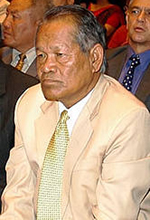 |
|
||
|
|
|
Nepal Study Center publishes an electronic newsletter on a regular basis with announcements such as, call for papers for its journals (HJDD and LDNB), seminar and workshop programs, article postings, and other scholarly events. Nepal Study Center is pleased to welcome Dr. Vijaya R. Sharma (U. of Colorado, Boulder) and Mr. Biswo Poudel (Berkeley) as co-editors of the Viewpoint feature of the newsletter.
For detailed Newsletter announcements CLICK HERE: NSC Newsletter Announcements
Insight, Issue 3:2006 Research notes and analytical opinion pieces Editors' Note: In this issue of Insight we present two papers, one related to the management of community forests and another related to efforts of a local government to promote industrial development in its area. Below are our introductory notes on the papers, and we invite readers to post their comments on the NSC website. Based on a household survey conducted in Kavrepalanchok and Sindhupalanchowk districts of Nepal, Bhim Adhikari and Jon C. Lovett show that incidences of transaction costs of community forestry schemes on different income groups (monetary and time expenditure on participation in meetings, information collection, travel, etc.) is regressive when measured as a percentage of resource appropriating costs ( costs incurred by households during collecting, harvesting and transporting forest products from community forest to their house). The incidences are estimated as less than 15 percent on the rich, but up to 26 percent on the poorer users. The authors recommend a special attention to address this equity issue to ensure success of community-based approaches towards natural resource management. Another paper summarizes Hyunjoo Yang’s astute and enlightened observations on approaches used by the Alabama state, city, and county governments to promote establishment of foreign auto manufacturers in Montgomery City. From these observations, the author draws lessons for his home town in Korea, the Incheon City, which has established a free economic zone to promote foreign investment in the city. The author also points out interesting cultural differences among American and Korean businesses. We think that the author’s recommendations to the Incheon City can even be used by other cities in other countries, including Nepal, to attract foreign investment. EditorsVijaya R. Sharma, Ph.D. U. of Colorado at Boulder Biswo Poudel , U. of California at Berkeley
Remembering Dr. Gurung by Dr. Pitambar Sharma Losing Dr. Harka Gurung by Dr. Devendra Raj Panday Memories of Dr. Harka Gurung by Dr. Shankar Sharma A Tribute to Dr. Harka Gurung by Dr. Ambika P. Adhikari
Insight, Issue 2:2006 Research notes and analytical opinion pieces Editors' Note: In this issue we present summary descriptions of two research papers written on Nepal and encourage readers to share their comments on these articles. 1. “Returns to Education in Nepal” by Yubraj Acharya of Swarthmore College 2. “Does Exposure to Indoor Cooking Smoke Increases the Risk of Cataracts? Can We Prevent Cataracts by Introducing Improved Cooking Stove?” by Amod Pokhrel of University of California at Berkeley The first paper examines the impact of education on poverty reduction. It argues that the conventional practice of using impact of education on earnings to assess its impact on poverty reduction is flawed for a number of reasons. Instead, the paper chooses to assess the impact of three levels of education – primary, secondary, and post secondary – on a few social indicators of poverty reduction – whether education encouraged a household to own a latrine, whether education encouraged a household to immunize at least one child against diseases, whether education encouraged a household to use at least one improved variety of seed in agriculture, and whether education encouraged a household to use at least one advanced machine, such as tractor, water pump, or trolley in agriculture. The study finds that primary education yielded the highest marginal payoff, compared to the payoffs of secondary and post-secondary education to the above-mentioned social indicators. The second paper explores the relationship between use of different types of cooking stoves and the incidence of cataract among women by conducting a cataract case–control study in the area of the Nepal–India border where cooking with solid fuels in unvented indoor stoves is a common practice. To evaluate an individual’s probability of having cataracts as a function of risk factors, a logistic regression model is used. The study finds that the most effective measure of preventing cataracts among women would be to replace unflued stoves with flued stoves, which vent cooking smoke directly to the exterior of the house, and to ideally use stoves with cleaner burning fuels. Editors
Insight, Issue 1:2005 Research notes and analytical opinion pieces Editors' Note: The 12-point agreement between the seven-party alliance and the Maoists is a historical political event of immense significance. In this agreement the two signatory groups agree to keep open discussion on whether their movement for democracy should demand CA election or the revival of the dissolved House of Representatives to lead to CA election. Below we present views of two prominent Nepali intellectuals on which is a better option for restoring people's sovereignty and liberal democracy in Nepal. We encourage readers to post comments on any or all viewpoints. Editors Vijaya R. Sharma, Ph.D., University of Colorado at Boulder Biswo Poudel , University of California at Berkeley
|
| Home | Objectives | Friends | Giving | Announcements | Feedback | Links | Photos | Contact Us | |||
| Copyright © 2005 nepalstudycenter.unm.edu - All Rights Reserved. |


